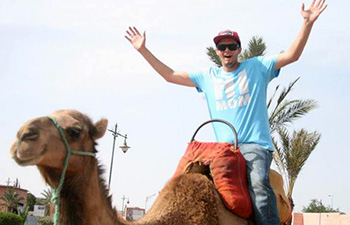The Design Thinking Action Lab online class has created the largest design team in the world, bringing together 45,000 students in fields ranging from engineering to education to business. Class member and engineering student Wade Colburn learned about the impact of design thinking and entrepreneurship aboard a ship during Semester at Sea.

Wade Colburn traveled around the world in spring 2013 with Semester at Sea, where he took courses and met with mentors such as Archbishop Desmond Tutu (left).
Read more student profiles »
Growing up, Wade Colburn wanted to be a doctor. The opportunities inherent in the field of regenerative medicine fascinated him. Coming from a family immersed in the sciences — his father is a veterinarian — a career in medicine had always seemed natural. When Colburn started college at North Carolina State University, he chose a major in biomedical engineering so he could pursue this path.
It was on a ship halfway around the world that Colburn fully realized the difference he could make in the lives of others by combining his passions for medicine and engineering with an entrepreneurial mindset and the design thinking process.
During his first three years at NC State, he embarked upon two Semester at Sea programs: one month-long Maymester trip to Central America in Spring 2011, and one semester-long program in Spring 2013, which took him around the world.
These immersive experiences changed Colburn. He learned from the lives and experiences of people he met during his travels to 12 countries including Japan, Ghana to India; he worked with hundreds of students from across the country who were part of the trip; and he benefitted from the wisdom of faculty mentors and representatives of companies and governments who joined the students on board.

On his voyage in 2013, which was a partnership between Semester at Sea and the Unreasonable Institute, Colburn took a course called “Sustainable Global Entrepreneurship.” Taught by George Kembel, co-founder of Stanford University’s Hasso Plattner School of Design (d.school), the design-centric course was focused on helping entrepreneurial students investigate how the world is adapting to solve social and environmental challenges. The course gave students the opportunity to work with companies and organizations on several challenges. Colburn worked with the Nike Foundation on their Girl Effect program to reinvent the concept of girl empowerment and turn it into a movement that could influence everyday users.
During the course, Kembel introduced Colburn and his fellow students to the design thinking process.
“We were going through the [design] process, and I kept wanting to jump to conclusions,” Colburn said. “I find that in engineering as well: we always want to figure out how we’re going to solve the problem. Then I realized that was the least important thing, and we needed to think about the consumer first.”
Colburn, who returned from his semester abroad in May 2013, signed up for the Design Thinking Action Lab to continue his learning and to share his insights with others. He said that it was valuable to have a learning squad for feedback while working on the course design challenge. During the week when class participants were asked to interview stakeholders for the empathy stage of the process, Colburn was surprised at the results within his group.
“We all had similar findings no matter who we talked to, but we all came up with a different problem statement or focus,” he said.
The course challenge to redesign the school-to-work transition, Colburn said, was very personal to him, as he remains unsure of what he’ll do after graduation. He could pursue the regenerative medicine field by continuing his education in graduate school, apply his design thinking skills to healthcare technology in the developing world, or take the entrepreneurship route and create his own job.
“I don’t see how I could go any other direction other than using design thinking, whether it’s in a big company to help change their minds, or starting my own device company,” he said. “Design thinking brings innovation where you least expect it.”
Read more student profiles »


